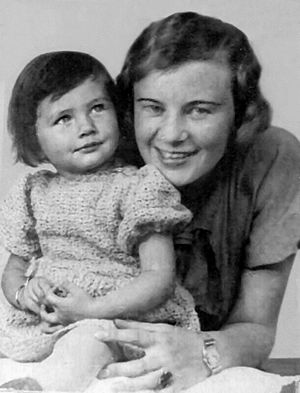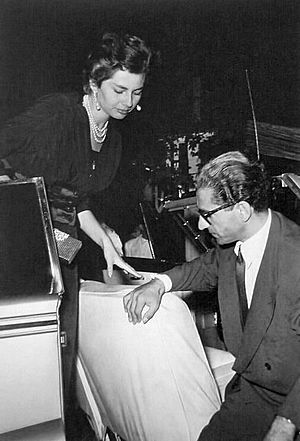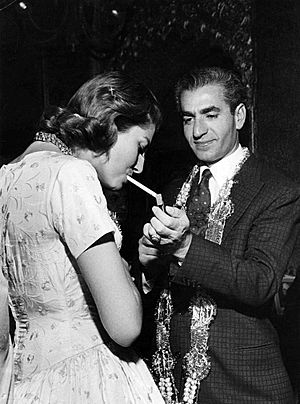Soraya Esfandiary-Bakhtiary facts for kids
Quick facts for kids Soraya Esfandiary-Bakhtiari |
|
|---|---|
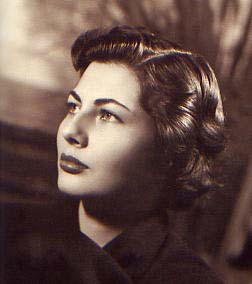
Soraya in 1953
|
|
| Queen consort of Iran | |
| Tenure | 12 February 1951 – 15 March 1958 |
| Born | 22 June 1932 Isfahan, Imperial State of Persia |
| Died | 26 October 2001 (aged 69) Paris, France |
| Burial | Westfriedhof, Munich, Germany |
| Spouse | |
| Father | Khalil Esfandiary-Bakhtiari |
| Mother | Eva Karl |
| Religion | Shia Islam, later Christianity |
| Occupation | Actress (1965) |
Soraya Esfandiary-Bakhtiari (Persian: ثریا اسفندیاری بختیاری, romanized: Sorayâ Esfandiâri-Baxtiâri; 22 June 1932 – 26 October 2001) was the Queen of Iran. She was the second wife of Shah Mohammad Reza Pahlavi. They married in 1951. Their marriage faced many challenges, especially because she could not have children. She did not want the Shah to marry another wife to have an heir. The Shah also did not want to step down from his role. In March 1958, they announced their divorce. After a short time as an actress, Soraya lived in Paris until she passed away.
Contents
Early Life and Education
Soraya was the only daughter of Khalil Esfandiary-Bakhtiari (1901–1983) and Eva Karl (1906–1994). Her father was a nobleman from the Bakhtiari people and Iran's ambassador to West Germany. Her mother was German, born in Russia.
Soraya was born in Isfahan, Iran, on 22 June 1932. She had one younger brother named Bijan. Her family had a long history of working in the Iranian government. Her uncle, Sardar Assad, was a leader in the Persian Constitutional Revolution. Soraya grew up in Berlin and Isfahan. She went to school in London and Switzerland.
Marriage to the Shah
In 1948, Soraya met Mohammed Reza Pahlavi, who was the Shah of Iran. He had recently divorced. A relative of Soraya's introduced them through a photograph. At that time, Soraya had finished high school in Switzerland. She was studying English in London. Soon after, they became engaged. The Shah gave her a large diamond engagement ring.
Soraya and the Shah married at Marble Palace in Tehran on 12 February 1951. They had planned to marry earlier, but the ceremony was delayed because Soraya was ill.
The Shah asked guests to donate money to a charity for the poor in Iran. However, they still received many gifts. These included a mink coat from Joseph Stalin and a special glass bowl from U.S. President Harry S. Truman. King George VI and Queen Elizabeth of the UK sent silver candlesticks. About 2,000 guests attended the wedding.
The wedding hall was decorated with 1.5 tons of flowers from the Netherlands. An equestrian circus from Rome provided entertainment. Soraya wore a beautiful silver dress designed by Christian Dior. Many people believed that Soraya was the Shah's "true love."
Soraya later wrote that she knew little about Iran's history or culture. She had grown up with a German and Catholic background. This made some people in Iran, especially Muslim religious leaders, question her. They felt the Shah should not marry a "half-European girl" who was not raised as a Muslim.
Queen of Iran
After her marriage, Soraya became the head of a family charity in Iran. Her marriage was sometimes difficult. The Shah's mother and sisters saw Soraya as a rival. They often treated her unkindly, just as they had treated his first wife.
During a difficult time with Prime Minister Mohammad Mosaddegh, the Shah was often sad. Soraya said he was "somber and distressed." In August 1953, Soraya went with the Shah when he had to leave Iran for a short time. They went to Rome.
After the Prime Minister was removed from power in 1953, the Shah became happier. Mohammad Reza and Soraya enjoyed masked balls. Soraya often praised her husband when he showed "European" qualities. She described his eyes as "expressive. Dark brown, almost black, shining, at times hard, at times sad or gentle."
Because Soraya grew up in Europe, Iran felt "strange" to her. She wrote about visiting hospitals and orphanages in Iran. She saw poverty and difficult living conditions. In contrast, she loved Paris and described it as "dazzling." She enjoyed simple things there, like going to cinemas.
In October 1954, the Shah told Soraya he was worried she had not given him a child to inherit the throne. He suggested they visit doctors in the United States. In 1954-1955, they took a long trip to the U.S. Doctors in New York told her that her inability to have children was due to stress. However, doctors in Boston told her she could not have children. This news made Soraya very sad.
Soraya was very interested in Hollywood. She met many American film stars during her visit to Los Angeles. These included Grace Kelly and Lauren Bacall. A photo of Queen Soraya water-skiing in Miami became very controversial in Iran. Some people criticized her for wearing a swimsuit, which was not seen as proper for a Muslim queen. The photo was banned in Iran.
In February 1955, the royal couple traveled to the United Kingdom. In London, they had dinner with Queen Elizabeth II at Buckingham Palace. They also met Prime Minister Winston Churchill. They then visited Soraya's parents in Cologne, Germany. On 12 March 1955, the Shah and Queen returned to Tehran. Many people came out to welcome them despite the rain.
Divorce
By early 1958, the marriage was in trouble because Soraya could not have children. The Shah's only child was his daughter, Princess Shahnaz Pahlavi, from his first marriage. The Shah felt that a child from his daughter's marriage could not continue the royal family line. He told Soraya she needed to give him a son. She had tried treatments in Switzerland, France, and the United States. The Shah suggested he take a second wife to have an heir, but Soraya did not agree.
To try and keep her position as Queen, Soraya suggested the Shah change the constitution. This would allow one of his half-brothers to become his heir. However, the Shah told her this would need approval from a "Council of Wise Men," which did not exist. The Shah's mother also wanted him to divorce Soraya. She believed it was his duty to have a son. The Shah convinced Soraya to leave Iran. He promised to try and change the constitution.
Soraya left Iran in February and went to her parents' home in Germany. The Shah sent her uncle to convince her to return, but it did not work. Soraya did not accept the idea of remaining queen while the Shah took another wife. On 5 March, the Shah called her and said she had to accept him taking a second wife or he would divorce her. On 10 March, a group of advisors met with the Shah to discuss the marriage. Four days later, it was announced that they would divorce.
The Iranian government announced that Soraya had agreed to the divorce. Soraya later said she had not been told beforehand. She called it "a sacrifice of my own happiness." She told reporters that her husband had no choice but to divorce her. The divorce was officially finalized on 6 April 1958.
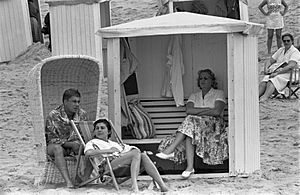
On 21 March 1958, the Iranian New Year's Day, the Shah announced his divorce to the Iranian people. He said he would not remarry quickly. The divorce inspired a French song called Je veux pleurer comme Soraya ("I Want to Cry Like Soraya").
Soraya was well compensated after the divorce. The Shah bought her a penthouse apartment in Paris. He also paid her a monthly allowance. She received luxury items like a Rolls-Royce Phantom IV car and valuable jewelry.
After the divorce, the Shah considered marrying Princess Maria Gabriella of Savoy. She was the daughter of the former Italian king. However, the Vatican newspaper expressed concerns about a Muslim ruler marrying a Catholic princess.
Career as Actress
After her divorce, Soraya lived in Munich for a short time. She later moved to France. She started a brief career as a film actress, using only her first name. She starred in the 1965 movie The Three Faces and became close with its Italian director, Franco Indovina. She also appeared in the 1965 movie She.
After Indovina died in a plane crash, Soraya lived the rest of her life in Europe. She wrote about her feelings in her 1991 memoir, Le Palais des solitudes (The Palace of Loneliness).
Later Years in Paris
In her later years, Soraya lived in Paris. She sometimes went to social events. Her friends tried to cheer her up. She often visited a famous hairdresser and enjoyed going to a hotel lobby near her apartment. Her former lady-in-waiting and a Parisian friend often accompanied her.
In 1979, Soraya wrote to Mohammad Reza when he was very ill. She told him she still loved him and wanted to see him. Mohammad Reza was touched by her letters and wrote back, saying he also loved her. They planned for her to visit him in Cairo, but he passed away before she could make the trip.
Death
Soraya died on 26 October 2001, in her apartment in Paris. She was 69 years old. This was also what would have been her former husband's 82nd birthday. Her younger brother, Bijan, sadly said, "After her, I don't have anyone to talk to." Bijan died one week later.
Her funeral was held in Paris. Many royal family members and friends attended. She was buried in Westfriedhof cemetery in Munich, Germany, next to her parents and brother.
After her death, some women claimed to be her daughter, born in 1962. However, none of these claims have been proven. Her belongings were sold at an auction in Paris in 2002 for over $8.3 million.
Memoirs
Princess Soraya wrote two memoirs. The first was published in 1964 and called Princess Soraya: Autobiography of Her Imperial Highness. Her second memoir, Le Palais des solitudes (The Palace of Loneliness), was published in French in 1991. It was later translated into English.
Legacy
Soraya's divorce inspired the French song "Je veux pleurer comme Soraya." A French rose grower named a sunflower "Empress Soraya" in her honor.
A TV movie about her life, called Soraya (also known as Sad Princess), was shown in 2003. It starred Anna Valle as Soraya.
Filmography
| Year | Title | Role | Notes |
|---|---|---|---|
| 1953 | Zwischen Glück und Krone | Herself | Archive Footage |
| 1965 | I tre volti | Herself/Linda /Mrs. Melville | |
| 1965 | She | Soraya | |
| 1998 | Legenden | Herself | Episode: "Soraya" |
See also
 In Spanish: Soraya Esfandiary para niños
In Spanish: Soraya Esfandiary para niños


